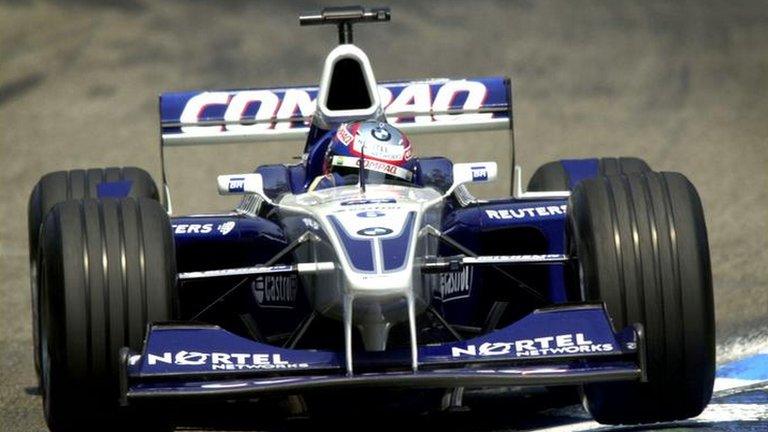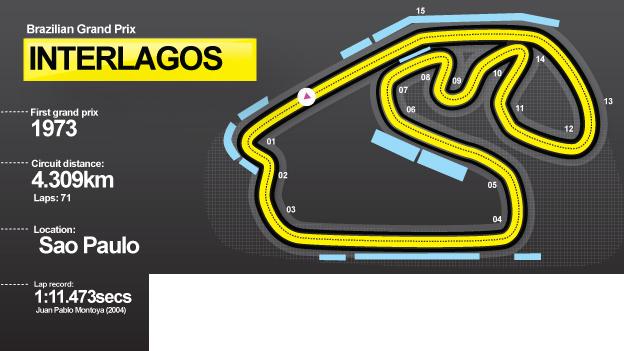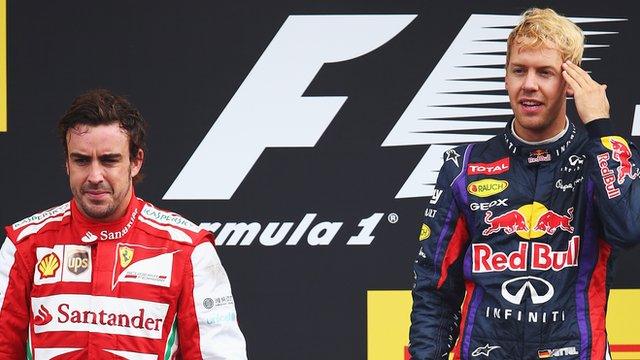Gary Anderson's Brazilian Grand Prix set-up guide
- Published
Watch out for Sauber's Nico Hulkenberg at this weekend's season-ending Brazilian Grand Prix; he could be a real pain for a lot of the big teams and drivers.
There are a lot of reasons to say that.
Sauber have made big steps forward since the summer break and Hulkenberg has been consistently qualifying well into the top 10 and occasionally in the top six or even higher - he qualified fourth on the grid in Austin last weekend and third in Italy in September.
Sao Paulo's Interlagos track will really suit the Sauber car. One of its key demands is for good traction out of the final corner up the long, kinked pit straight - and Sauber have great traction since they introduced new rear bodywork in the summer, complete with Red Bull-style exhaust-blowing for aerodynamic effect.
This uses the bodywork to guide the exhaust gases down to critical areas around the rear tyres, greatly enhancing rear downforce and therefore traction.
The approach to this used by Red Bull, Lotus and now Sauber is more effective than the different one adopted by most of the other teams.
On top of this, Hulkenberg always seems to go well in Brazil.
He was on pole there for Williams in damp conditions in 2010, external and led the race, also in the wet, last year for Force India before tangling with Lewis Hamilton's McLaren as they disputed the lead.
Lots of spice, but little depth
The Brazilian Grand Prix often produces great races, but Interlagos is not a great race track.
It's not the most challenging circuit in the world, it's a bit stop-and-go and there are only really two properly challenging corners.
The corner behind the pits, the fast uphill right-hander called Ferra Dura, is where the good cars really stand out from the bad ones.
The driver is coming uphill into it and slowing down as he's turning in. That is the biggest challenge for a modern F1 car because it puts lots of load into the tyres, and the Pirellis do not like doing two things at once.
The last corner is very important for traction. It is uphill, cambered a little and good traction means good exit speed, which carries all the way up the straight.
The rest of the track is not that demanding - even the fast, downhill left-hander at the end of the lap called Mergulho, which gets a lot of attention.
It's a decent corner, but it is flat out in a half-decent car, although it is a bit tricky if it is wet or if the driver is lacking confidence in the car.
Other than that, the corners in the midfield are very stop-go and it is a very short lap.
But it produces great racing because of that. The cars are closely matched and the mega drivers cannot stand out so easily. So the not-so-good cars and drivers can end up mixing it with the good guys.
The car needs to be compliant, turn well and put the power down well in slow corners but very few of them make good cars stand out.
Into thin air
The altitude means there is less power, less downforce and less drag, which all sort of balances itself out.
The long straight up the hill out of the last corner, which has big curve in the middle of it, means teams are forced to run less downforce than would be ideal for the best lap time.
Overtaking is not that difficult into the first corner - the Senna S - so there is no point running high downforce levels because that would make a driver too vulnerable to being overtaken in the race.
That compromises the car a touch in the case of wet weather, which is pretty common in Brazil. It always seems to rain at some point in the weekend, and that often leads to crazy, mixed-up races and changing conditions.
Even if the forecast is for rain, it is a gamble to go for a wet set-up with more downforce because the weather is so unpredictable and if it ends up dry the driver will be a sitting duck on the straight.
The circuit itself is quite tricky in the wet because a lot of 'rivers' run across it as a result of the changing topography of the land.
The organisers have tried to address that in the last few years but is still an issue, and that makes it very tricky for the drivers, because aquaplaning is a real issue.
Last battle in a long war
The same names will feature at the front, with Red Bull leading the way from Lotus and Mercedes, with Ferrari latching on to the back. And despite the nature of the track, I think it's unlikely that Mercedes and Lotus will be any closer to Red Bull.
Mercedes are still marginal on their rear tyres, which compromises their race pace, and that will hurt them in Brazil because of the traction demands.
But I would expect Lotus to be very strong. Romain Grosjean has been driving fantastically well recently, and the team are doing a great job.
Gary Anderson, the former technical director of the Jordan, Stewart and Jaguar teams, was talking to BBC Sport's Andrew Benson
- Published20 November 2013

- Published20 November 2013

- Published19 November 2013
